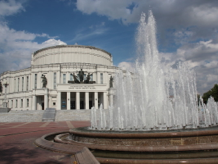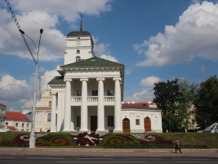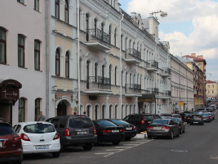Nauru Travel Diary

From Houston to Sydney 2013
From Houston
to Sydney
2013
In many ways, to visit Belarus is to experience many aspects of life in the former Soviet Union. Despite some gestures towards privatization, most of the economy remains in government hands – a large majority of farming, for example, is state-run following the Soviet system of kolkhozes (collectives) and sovkhozes (state farms), and most manufacturing is also state-run. Commercial advertising is discreet and minimal, the KGB still operates, and references to the Soviet-era, communism, socialism and the defeat of fascism seem to roll off people’s tongues with easy fluency and a positive slant. In contrast to the trend in other parts of the former Soviet Union, communist emblems and insignias on buildings in Belarus are being restored and emphasized. Stalin is spoken of positively, and although I have not seen any statues of him, I have heard that they still exist here.
Belarus is not generally regarded as one of the world’s top tourism honeypots. Perhaps that is why sightseeing options in Minsk are somewhat limited. However, just a few months ago, an enterprising businessman bought an old double decker MAN bus from somewhere in Europe, painted it red, and began running city tours with commentaries via earphones in seven languages. This is not the “hop on, hop off” model used in many other cities around the world. It is called “hop in”, there are just four trips each day, and you must start and finish at the main railway station.
Fortunately, the railway station was just five minutes walk from our hotel, so Di and I decided to take the first of today’s four trips, scheduled to leave the station at 11 am. (The later trips were scheduled at 1:30 pm, 4:00 pm and 6:30 pm). We found the bus easily, and it turned out to be what I thought was a real bargain – a two hour trip for just 100,000 roubles per person. To place this in context, the current exchange rate is 8,875 roubles to the US dollar; visiting Belarus has been a great opportunity to brush up on my 8,875 times tables.
Although the weather report had forecast a sunny day with just a few clouds, the sky was completely overcast as our trip began, and at one point in the journey we even had a very light shower of rain. The grey conditions, combined with the dirty windows and the scratched reflective film on the windows made photography somewhat difficult, although I did manage a few decent shots, especially towards the end of the trip when the clouds cleared and the sun began to shine.
The commentary was informative, even if a little stilted and accented; it is always good to hear about resilient and brave people fighting selflessly for socialism in the face of the peril of fascist onslaught when one is touring a city. The peasant-inspired woodwind music that filled the time between each burst of the commentary also added a nice touch of local culture.
The bus began its tour by proceeding to the north-east along Niezaliežnasci Praspyekt, the wide boulevard where Di and I had gone walking yesterday afternoon. All this area was destroyed by bombing during World War II and was re-built in grand, elegant, Stalinist style in the early 1950s. In the words of one website “More than 90% of Minsk was destroyed during World War II, so there are hardly any buildings left older then 60 years. The best and most famous Soviet architects totally rebuilt the ‘Hero City’ directly after the war in monumental social realist style”. Today, Niezaliežnasci Praspyekt is the best preserved avenue of Stalinist architecture in the world, and is thus a candidate for a UNESCO world heritage listing.
Our drive took us past Independence Square, the Palace of the Republic, the KGB headquarters building with its statue of Felix Dzerzhinsky opposite, the Circus, Pobedy Square (Victory Square, with its 40 metre obelisk memorial to the country’s war dead), the Academy of Sciences, the Botanical Garden and the new crystal-shaped National Library building. Our most north-eastern point was All Saints Church, a new (1998) Russian Orthodox church where we were allowed to disembark and explore for ten minutes.
We returned towards the city centre along Niezaliežnasci Praspyekt, but half-way along that journey, we turned off and headed towards the north-west. We first passed a small area (one tiny block) of preserved old buildings before the journey continued into a newer area of Minsk with a large amount of new construction and several (actually, many) huge sporting arenas for different sports. The journey ended 10 minutes before 1 o’clock where it began – at the beautiful Stalinist City Gates towers opposite the railway station.
The sun had come out towards the end of the bus trip, and the day had suddenly become much warmer as a consequence. We returned to the hotel for a drink and a slight change of clothes, and then set out to explore on foot the area that we had both especially admired from the bus, the small area of historic buildings known as “Trinity Suburb” (‘Trojeckaje Pradmiescie’, and/or ‘Trayetskaye Pradmestsye’ and/or ‘Troitskoe Predmest’e’ – there seem to be many transliterations available).
Getting to Trinity Suburb, apparently also known as Trinity Hill, involved a short walk of about a kilometre from our hotel, first along Communist Youth League Boulevard, and then along Lenin Boulevard. Trinity (let’s just call it that) takes its name from the Trinity Convent, almost none of which remains – although several other recently built and restored churches are located across the road. Today, Trinity is a tiny block of land that is significant not for its size, but because it is the only place in Minsk where 15th to 19th century houses can still be seen.
Trinity is also significant because it is the site of the Island of Tears Memorial, which is a monument to Belarusian soldiers who lost their lives during the USSR’s nine-year war in Afghanistan (1979-1988). Reached by crossing a small bridge, the centerpiece of this emotionally moving monument is a small chapel surrounded by the haunting copper sculptures of grieving mothers.
Off to one side of the main memorial, towards the end of the island near some small stones that bear the names of Afghan cities in Cyrillic – Kabul, Kandahar, and so on – is a small fountain with a boy-like figure of an angel, said to be the guardian angel of Belarus. Interestingly, his penis was far shinier than the rest of the sculpture, a phenomenon that can be explained by the Belarusian tradition whereby newlyweds visit war memorials on their wedding day, together with a modern folk belief that if the bride gropes this poor young lad’s privates, she will be guaranteed children. Astonishingly, Di had not noticed the shiny penis!!!!!
Having explored Trinity, we headed north-east to the edge of Janka Kupala Park where the Great Theatre was located. This beautiful building, which to give it its full name is the “National Academic Bolshoi Opera and Ballet Theatre of the Republic of Belarus”, was opened in 1939. Round in shape and beautifully decorated in the best of Soviet style, the building looked magnificent, especially when the fountain in front was at its full height (the fountain featured water with different shapes and heights from its jets at various times).
As the clouds started to accumulate overhead once again, we made our way back to the hotel, stopping on the way to photograph a large Soviet style wall sculpture over some shops at the corner of Svabody Boulevard and Niamha Boulevard.
It was a great finish to an excellent day’s sightseeing, during which Di commented that the city was better than she had been expecting. I was more enthusiastic, finding Minsk to be elegant, orderly, clean and quite simply, fascinating.

Day 38 - Minsk
Monday
12 August 2013








































